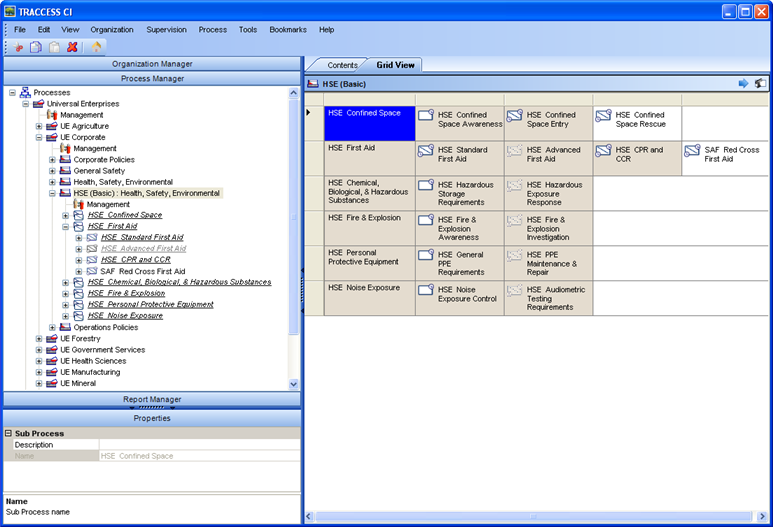
|
|
|
|
The Grid View provides the SME a visual representation of how a Process will appear to the Learner in their My Job.

The Grid View for a Process contains several pieces of information.
Clicking on the ![]() button displays the Task Names. By default, the grid view does not display the Task Names.
button displays the Task Names. By default, the grid view does not display the Task Names.

Clicking on the ![]() button would expand Tasks with Levels, where applicable. By default, the grid view appears with the Tasks with Levels collapsed.
button would expand Tasks with Levels, where applicable. By default, the grid view appears with the Tasks with Levels collapsed.
Tasks on a white background indicate that the Task can be edited. Tasks on a tan background indicate that this Task does not originate here (applies to a Derived process only), and that the Task properties cannot be edited here.
![]()
Derived Process Only - Task icons that are "normal" will appear in the Derived Process. Task icons that are "lighter" will not appear in the Derived Process.
![]()
Tasks can be dragged/ dropped within the grid view, from the grid view to the tree control, or from the tree control to the grid view.
Cut
Copy
Paste
Delete - this removes the Sub Process from the database. The Tasks that existed in this Sub Process remain in the database, and can be accessed by right-clicking on another Sub Process, and selecting Add/ Remove Tasks.
Rename - puts the Sub Process in inline edit mode, ready to be modified.
New Task (formerly known as Folder) - when a Sub Process is selected, a new Task can be created. A Task can contain Resources, a SCORM Resource, a Knowledge Assessment and a Capability Assessment. This is the piece that is measured and that is recorded in the TRACCESS database. An example of a Task is "Start Up Equipment X", "Operate Equipment X", "Shut Down Equipment X", or "Troubleshoot Equipment X"
New Task with Levels - when a Sub Process is selected, a new Task with Levels can be created. A Task with Levels can contain a set number of Competence Levels (by default, this value is 3). The names of the Competence Levels are globally set, and are Basic, Skilled and Mastery by default. Each competence level can have its own resources, a SCORM resource, a Knowledge Assessment and a Capability Assessment.
Add/ Remove Task - when the Sub Process is selected, an existing Task can be added to the current location. For this reason, it is recommended to classify your Tasks using some sort of naming convention. In this way, if you decided to use COR (Corporate), FIN (Finance), OPS (Operations), MTS (Maintenance) as prefixes for your Tasks, this dialog would sort all of your tasks in their specific areas. If you were looking for a corporate task, you would concentrate on the CORs, etc.
Add/ Remove Tasks with Levels - when the Sub Process is selected, an existing Task with Levels can be added to the current location.
Cut
Copy
Paste
Remove
Add Capability Assessment - when a Task is selected, a new Capability Assessment can be created. This serves as the checklist that a Supervisor/ Operational Administrator can use to ensure that the Learner has satisfied the practical or hands-on component of the Task.
Add ASSESS Capability Assessment - when a Task is selected a new Capability Assessment can be created. The ASSESS (Perception QuestionMark) Capability Assessment serves as an assessment that is written focusing on the Employee's accomplishments. For example, "The employee was able to ..."
Add Knowledge Assessment - when a Task is selected, a new Knowledge Assessment can be created. The internal Knowledge Assessment can contain True/ False, Yes/ No, Multiple Choice and Multiple Response question types.
Add ASSESS Knowledge Assessment - when a Task is selected, a new ASSESS Knowledge Assessment can be created. The ASSESS Knowledge Assessment can contain up to 20 different question types, but is dependent on your company having purchased an Perception QuestionMark license.
Add SCORM Knowledge Assessment - when a Task is selected, a new SCORM resource can be attached as the Knowledge Assessment.
Add SCORM Resource - when a Task is selected, a new SCORM resource can be attached as a stand-alone SCORM resource.
Hide Task - when a task is selected within a Derived Process, this option allows you to hide the task.
Show Task - when a previously-hidden task is selected within a Derived Process, this option allows you to show the task.
Add/ Remove Owners - if your configuration has more than one person set as Subject Matter Experts, you may wish to tag each task with specific owners, and subsequently set the Role Permission Set function permission for a Subject Matter Expert to disable a function called "Edit All Tasks (Owner Override)". In this way, only Task owners would have the right to manipulate the information within a Task, even if they have access to that Task (using the Add/ Remove Tasks function, or if they happen to be Subject Matter Experts over the main process).
Add/ Remove Prerequisites - when a Task is selected, an existing Task can be used as a Prerequisite. Not all Tasks contain prerequisites, but it may be a useful feature in certain cases to ensure that certain Tasks are completed in a set order.
Rename
|
|
|
|